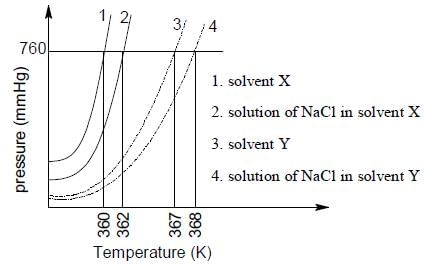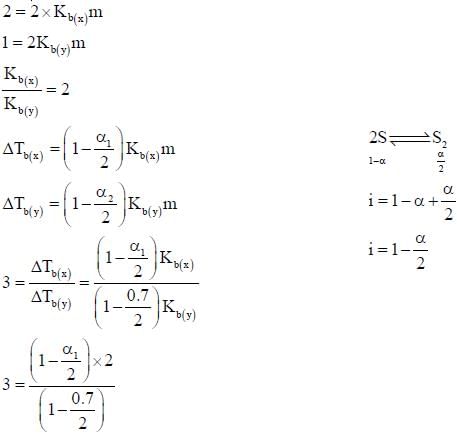JEE Exam > JEE Questions > The plot given below shows P—T curves (...
Start Learning for Free
The plot given below shows P—T curves (where P is the pressure and T is the temperature) for two
solvents X and Y and isomolal solutions of NaCl in these solvents. NaCl completely dissociates in both the
solvents.

On addition of equal number of moles of a non-volatile solute S in equal amount (in kg) of these solvents, the elevation of boiling point of solvent X is three times that of solvent Y. Solute S is known to undergo dimerization in these solvents. If the degree of dimerization is 0.7 in solvent Y, the degree of dimerization in solvent X is _________.
solvents X and Y and isomolal solutions of NaCl in these solvents. NaCl completely dissociates in both the
solvents.

On addition of equal number of moles of a non-volatile solute S in equal amount (in kg) of these solvents, the elevation of boiling point of solvent X is three times that of solvent Y. Solute S is known to undergo dimerization in these solvents. If the degree of dimerization is 0.7 in solvent Y, the degree of dimerization in solvent X is _________.
Correct answer is '0.05'. Can you explain this answer?
| FREE This question is part of | Download PDF Attempt this Test |
Verified Answer
The plot given below shows P—T curves (where P is the pressure a...



|
Explore Courses for JEE exam
|

|
Similar JEE Doubts
The plot given below shows P—T curves (where P is the pressure and T is the temperature) for twosolvents X and Y and isomolal solutions of NaCl in these solvents. NaCl completely dissociates in both thesolvents.On addition of equal number of moles of a non-volatile solute S in equal amount (in kg) of these solvents, the elevation of boiling point of solvent X is three times that of solvent Y. Solute S is known to undergo dimerization in these solvents. If the degree of dimerization is 0.7 in solvent Y, the degree of dimerization in solvent X is _________.Correct answer is '0.05'. Can you explain this answer?
Question Description
The plot given below shows P—T curves (where P is the pressure and T is the temperature) for twosolvents X and Y and isomolal solutions of NaCl in these solvents. NaCl completely dissociates in both thesolvents.On addition of equal number of moles of a non-volatile solute S in equal amount (in kg) of these solvents, the elevation of boiling point of solvent X is three times that of solvent Y. Solute S is known to undergo dimerization in these solvents. If the degree of dimerization is 0.7 in solvent Y, the degree of dimerization in solvent X is _________.Correct answer is '0.05'. Can you explain this answer? for JEE 2024 is part of JEE preparation. The Question and answers have been prepared according to the JEE exam syllabus. Information about The plot given below shows P—T curves (where P is the pressure and T is the temperature) for twosolvents X and Y and isomolal solutions of NaCl in these solvents. NaCl completely dissociates in both thesolvents.On addition of equal number of moles of a non-volatile solute S in equal amount (in kg) of these solvents, the elevation of boiling point of solvent X is three times that of solvent Y. Solute S is known to undergo dimerization in these solvents. If the degree of dimerization is 0.7 in solvent Y, the degree of dimerization in solvent X is _________.Correct answer is '0.05'. Can you explain this answer? covers all topics & solutions for JEE 2024 Exam. Find important definitions, questions, meanings, examples, exercises and tests below for The plot given below shows P—T curves (where P is the pressure and T is the temperature) for twosolvents X and Y and isomolal solutions of NaCl in these solvents. NaCl completely dissociates in both thesolvents.On addition of equal number of moles of a non-volatile solute S in equal amount (in kg) of these solvents, the elevation of boiling point of solvent X is three times that of solvent Y. Solute S is known to undergo dimerization in these solvents. If the degree of dimerization is 0.7 in solvent Y, the degree of dimerization in solvent X is _________.Correct answer is '0.05'. Can you explain this answer?.
The plot given below shows P—T curves (where P is the pressure and T is the temperature) for twosolvents X and Y and isomolal solutions of NaCl in these solvents. NaCl completely dissociates in both thesolvents.On addition of equal number of moles of a non-volatile solute S in equal amount (in kg) of these solvents, the elevation of boiling point of solvent X is three times that of solvent Y. Solute S is known to undergo dimerization in these solvents. If the degree of dimerization is 0.7 in solvent Y, the degree of dimerization in solvent X is _________.Correct answer is '0.05'. Can you explain this answer? for JEE 2024 is part of JEE preparation. The Question and answers have been prepared according to the JEE exam syllabus. Information about The plot given below shows P—T curves (where P is the pressure and T is the temperature) for twosolvents X and Y and isomolal solutions of NaCl in these solvents. NaCl completely dissociates in both thesolvents.On addition of equal number of moles of a non-volatile solute S in equal amount (in kg) of these solvents, the elevation of boiling point of solvent X is three times that of solvent Y. Solute S is known to undergo dimerization in these solvents. If the degree of dimerization is 0.7 in solvent Y, the degree of dimerization in solvent X is _________.Correct answer is '0.05'. Can you explain this answer? covers all topics & solutions for JEE 2024 Exam. Find important definitions, questions, meanings, examples, exercises and tests below for The plot given below shows P—T curves (where P is the pressure and T is the temperature) for twosolvents X and Y and isomolal solutions of NaCl in these solvents. NaCl completely dissociates in both thesolvents.On addition of equal number of moles of a non-volatile solute S in equal amount (in kg) of these solvents, the elevation of boiling point of solvent X is three times that of solvent Y. Solute S is known to undergo dimerization in these solvents. If the degree of dimerization is 0.7 in solvent Y, the degree of dimerization in solvent X is _________.Correct answer is '0.05'. Can you explain this answer?.
Solutions for The plot given below shows P—T curves (where P is the pressure and T is the temperature) for twosolvents X and Y and isomolal solutions of NaCl in these solvents. NaCl completely dissociates in both thesolvents.On addition of equal number of moles of a non-volatile solute S in equal amount (in kg) of these solvents, the elevation of boiling point of solvent X is three times that of solvent Y. Solute S is known to undergo dimerization in these solvents. If the degree of dimerization is 0.7 in solvent Y, the degree of dimerization in solvent X is _________.Correct answer is '0.05'. Can you explain this answer? in English & in Hindi are available as part of our courses for JEE.
Download more important topics, notes, lectures and mock test series for JEE Exam by signing up for free.
Here you can find the meaning of The plot given below shows P—T curves (where P is the pressure and T is the temperature) for twosolvents X and Y and isomolal solutions of NaCl in these solvents. NaCl completely dissociates in both thesolvents.On addition of equal number of moles of a non-volatile solute S in equal amount (in kg) of these solvents, the elevation of boiling point of solvent X is three times that of solvent Y. Solute S is known to undergo dimerization in these solvents. If the degree of dimerization is 0.7 in solvent Y, the degree of dimerization in solvent X is _________.Correct answer is '0.05'. Can you explain this answer? defined & explained in the simplest way possible. Besides giving the explanation of
The plot given below shows P—T curves (where P is the pressure and T is the temperature) for twosolvents X and Y and isomolal solutions of NaCl in these solvents. NaCl completely dissociates in both thesolvents.On addition of equal number of moles of a non-volatile solute S in equal amount (in kg) of these solvents, the elevation of boiling point of solvent X is three times that of solvent Y. Solute S is known to undergo dimerization in these solvents. If the degree of dimerization is 0.7 in solvent Y, the degree of dimerization in solvent X is _________.Correct answer is '0.05'. Can you explain this answer?, a detailed solution for The plot given below shows P—T curves (where P is the pressure and T is the temperature) for twosolvents X and Y and isomolal solutions of NaCl in these solvents. NaCl completely dissociates in both thesolvents.On addition of equal number of moles of a non-volatile solute S in equal amount (in kg) of these solvents, the elevation of boiling point of solvent X is three times that of solvent Y. Solute S is known to undergo dimerization in these solvents. If the degree of dimerization is 0.7 in solvent Y, the degree of dimerization in solvent X is _________.Correct answer is '0.05'. Can you explain this answer? has been provided alongside types of The plot given below shows P—T curves (where P is the pressure and T is the temperature) for twosolvents X and Y and isomolal solutions of NaCl in these solvents. NaCl completely dissociates in both thesolvents.On addition of equal number of moles of a non-volatile solute S in equal amount (in kg) of these solvents, the elevation of boiling point of solvent X is three times that of solvent Y. Solute S is known to undergo dimerization in these solvents. If the degree of dimerization is 0.7 in solvent Y, the degree of dimerization in solvent X is _________.Correct answer is '0.05'. Can you explain this answer? theory, EduRev gives you an
ample number of questions to practice The plot given below shows P—T curves (where P is the pressure and T is the temperature) for twosolvents X and Y and isomolal solutions of NaCl in these solvents. NaCl completely dissociates in both thesolvents.On addition of equal number of moles of a non-volatile solute S in equal amount (in kg) of these solvents, the elevation of boiling point of solvent X is three times that of solvent Y. Solute S is known to undergo dimerization in these solvents. If the degree of dimerization is 0.7 in solvent Y, the degree of dimerization in solvent X is _________.Correct answer is '0.05'. Can you explain this answer? tests, examples and also practice JEE tests.

|
Explore Courses for JEE exam
|

|
Suggested Free Tests
Signup for Free!
Signup to see your scores go up within 7 days! Learn & Practice with 1000+ FREE Notes, Videos & Tests.























